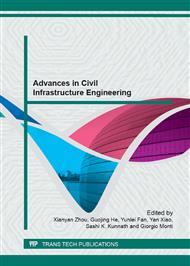[1]
J.H. Prévost, Plasticity theory for soil stress behavior, Journal of Engineering Mechanics, ASCE. Vol.104,5(1978) 1177-1194.
Google Scholar
[2]
Z.Mrõz, V.A. Norris, O.C. Zientiewicz, An anisotropic hardening model for soils and its application to cyclic loading. International Journal for Numerical and Analytical Methods in Geomechanics. 2(1978) 203-221.
DOI: 10.1002/nag.1610020303
Google Scholar
[3]
S.Sture, J.C. Mould, H.-Y. Ko, Modeling of elastic-plastic anisotropic hardening constitutive model and prediction of behavior of dry quartz sand, in: Constitutive Relations for Soils, Gudenhus G, Darve F, Vardoulakis I. (eds). A. A. Balkema, Rotterdam, Netherlands, 1982, pp.227-248.
Google Scholar
[4]
P.A. Vermeer, A five-constant model unifying well-established concepts, in: Constitutive Relations for Soils, Gudenhus G, Darve F, Vardoulakis I. (eds). A. A. Balkema, Rotterdam, Netherlands, 1982, pp.175-198.
Google Scholar
[5]
J.P. Bardet, Bounding surface plasticity model for sands, Journal of Engineering Mechanics, ASCE. Vol.112,11(1985) 1198-1217.
DOI: 10.1061/(asce)0733-9399(1986)112:11(1198)
Google Scholar
[6]
D. Muir Wood, K. Belkheir, D.F. Liu, Strain softening and state parameter for sand modelling, Géotechnique. Vol.44,2(1994) 335-339.
DOI: 10.1680/geot.1994.44.2.335
Google Scholar
[7]
A. Gajo, D. Muir Wood, A kinematic hardening constitutive model for sands: the multiaxial formulation, International Journal for Numerical and Analytical Methods in Geomechanics. 23(1999) 925-965.
DOI: 10.1002/(sici)1096-9853(19990810)23:9<925::aid-nag19>3.0.co;2-m
Google Scholar
[8]
J.Ghaboussi, H. Momen, Plasticity model for cyclic behavior of sands, in: Proc. 3rd. Int. Conf. Numerical Methods in Geomechanics, Aachen. 1979, pp.423-434.
Google Scholar
[9]
S. Piestruszczak, H.B. Poorooshasb, On modelling of cyclic behaviour of soils, in: Developments in Soil Mechanics and Foundation Engineering - 2, Banerjee, P.K., & Butterfield, R. (eds)., Elsevier, 1985, pp.139-184.
Google Scholar
[10]
M.Klisinski, M.M. Alawi, S.Sture, H.-Y.Ko, D. Muir Wood, Elasto-plastic model for sand based on fuzzy sets, in: Constitutive Equations for Granular Non-cohesive Soils, Saada, Bianchini (eds),, Balkema, Rotterdam, Netherlands, 1988.
Google Scholar
[11]
M.Klisinski, Plasticity theory based on fuzzy sets, Journal of Engineering Mechanics, ASCE, Vol.114,4(1991) 593-582.
Google Scholar
[12]
Y.-N.Ge, S.Sture, Cyclic constitutive model based on fuzzy sets concepts, in: Constitutive Modeling of Geomaterials, Ling, H.I., Anandarajah, A., Manzari, M.T., Kaliakin, V.N., & Smyth, A. (eds)., CRC Press, 2003, pp.108-112.
Google Scholar
[13]
Y.-N.Ge, S.Sture, Integration and application of a cyclic plasticity model for geomaterials, in: Proceedings of the 16th ASCE Engineering Mechanics Division Conference, Seattle, WA, 2003.
Google Scholar
[14]
C.Chen, Y.-N.Ge, Modeling permanent deformation and resilient modulus of unbound granular materials under repeated loads, International Journal of Geomechanics, Vol.10, 6(2010) 236-241.
DOI: 10.1061/(asce)gm.1943-5622.0000025
Google Scholar
[15]
K.J. Willam, E.P. Warnke, Constitutive model for the triaxial behavior of concrete, in: Seminar on Concrete Structures Subjected to Triaxial Stresses, ISMES, Bergamo, Italy, 1974.
Google Scholar
[16]
K,Been, M.G. Jefferies, A state parameter for sands, Géotechnique. Vol.35,2(1985) 99-112.
DOI: 10.1680/geot.1985.35.2.99
Google Scholar
[17]
T.B.S, Pradhan, F.Tatsuoka, Y.Sato, Experimental stress-dilatancy relations of sand subjected to cyclic loading, Soils and Foundations, Vol.29,1(1989) 45-64.
DOI: 10.3208/sandf1972.29.45
Google Scholar
[18]
F.Tatsuoka, K.Ishihara, Drained deformation of sand under cyclic stresses reversing direction, Soils and Foundations, Vol.14,3(1974) 51-65.
DOI: 10.3208/sandf1972.14.3_51
Google Scholar


